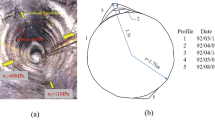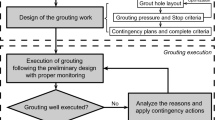Abstract
One of the most important dangers that treat earth dams which can lead to interior failure over a prolonged period is the hydraulic fracturing factor. In the case of zoned dams, due to differences in stiffness of the core and its abutment zone, differential settlements occur between them. This factor is responsible for the arching phenomenon. Differential settlements between core and shell cause cracks within the core initially sub-surface, Those cracks may develop the first impounding causing internal erosion on the dam core. In this research, using a computer modeling of Ghavoshan rockfill dam (located the west part of Iran) as a case study computed by SIGMA/W program, the role of the dam core shape on those factors is demonstrated. It is found that an inclined core shape is preferred in a condition that is especially important settlements of construction during for dam body. The result of finite element analysis indicates desired conditions from the point of view of stress, deformation and resistance against hydraulic fracturing for the same width of dam designs. Moreover, this can be higher priority for embankment dam designs.












Similar content being viewed by others
References
Babb AO, Mermel TW (1968) Catalog of dam disasters, failures and accidents. US Bureau of Reclamation, USA
French National Committee (1973) International watertight cores. Proceedings 11th ICOLD congress, vol III, Q42, R28, Madrid
Ghavoshan Powerhouse and Dam Design (2004) Second process: technical reports, attachment 4. Mahab Ghodss Consultant Engineers, Iran
Krahn J (2008) Stress-deformation modeling with SIGMA/W, 3rd edn. An engineering methodology. GEO-SLOPE International Ltd, Calgary, Alberta
Narita K (2000) Design and construction of Embankment dams. Department of Civil Engineering, Aichi Institute of Technology, Aichi
Ng AKL, Small JC (1999) A case study of hydraulic fracturing using finite element methods. Can Geotech J NRC Canada 36(5):861–875
Nobari ES, Duncan JM (1972) Movements in dams due to reservoir filling. Proceedings ASCE special conference on: performance of earth and earth supported structures. Purdue University, Lafayette, pp 797–815
Ogita S, Okumura T, Narita K, One Y (2002) Hydraulic fracturing in earth and rock-fill dams. Bulletin of Aichi Institute of Technology, Part B, no. 37, pp 123–130
Ohne Y, Narita K (1977) Discussion on cracking and hydraulic fracturing in fill-type dams. Special session 8, 9th ICSMFE
Ono K, Yamada M (1993) Analysis of arching action in granular mass. Geotechnique 43(1):105–120
Reinus E (1973) Some stability properties of having an inclined core. Proceedings of 11th ICOLD congress, vol II, Q42, R-2, Madrid
Sherard JL (1991) Cracking and hydraulic fracturing in Embankment dams. US Army Corps of Engineers, pp 301–327
Wang J-J, Zhu J-G, Mroueh H, Chiu CF (2007) Hydraulic fracturing of rock-fill dam. Multi-Science Publishing Co Ltd, Internat J Multiphy, vol 1,No. 2, pp. 199–219 (21)
Zienkiewicz OC, Naylor DJ (1986) Static analysis of embankment dams, ICOLD, Bulletin No. 53
Acknowledgments
The present study is funded by the University of Urmia. The support is gratefully acknowledged. Authors would also like to acknowledge Dr. Antony W. Wakefield of the University of Stanford of UK, for his valuable comments and discussions.
Author information
Authors and Affiliations
Corresponding author
Appendix
Appendix
1.1 Index
-
n% = porosity percentage
-
K = hydraulic conductivity
-
γ wet = Unit weight of wet soil
-
γ sat = Unit weight of saturated soil
-
ϕ = Friction angle of soil
-
C = cohesive strength of soil
1.2 Nonlinear Elastic (Hyperbolic) Model

-
R f = ratio between the asymptote to the hyperbolic curve and the maximum shear strength
-
K = modulus number describing the soil stiffness
-
K ur = unloading-reloading modulus
-
n = a value describing the rate of change of the soil stiffness as a function of the confining stress.
-
K b = bulk modulus
-
m = a value describing the rate of change of the bulk mudulus as a function of the confining stress.
Rights and permissions
About this article
Cite this article
Nayebzadeh, R., Mohammadi, M. The Effect of Impervious Clay Core Shape on the Stability of Embankment Dams. Geotech Geol Eng 29, 627–635 (2011). https://doi.org/10.1007/s10706-011-9395-z
Received:
Accepted:
Published:
Issue Date:
DOI: https://doi.org/10.1007/s10706-011-9395-z




